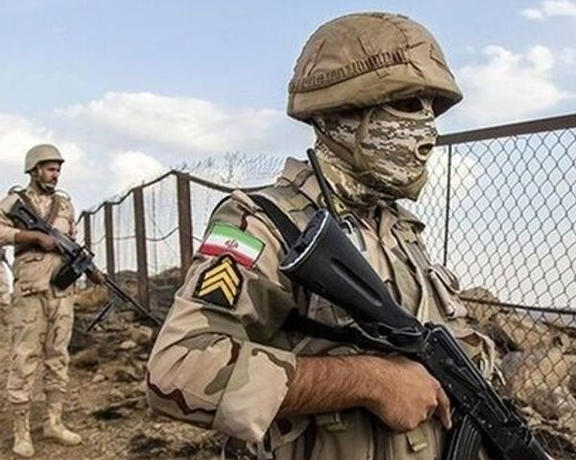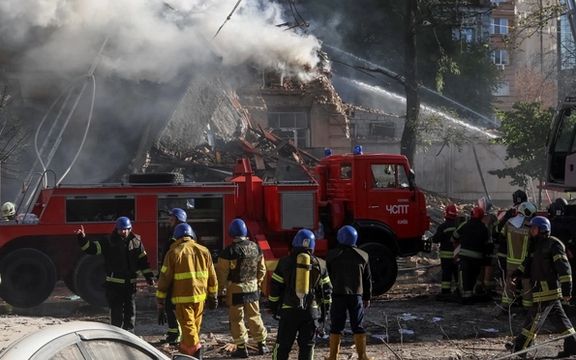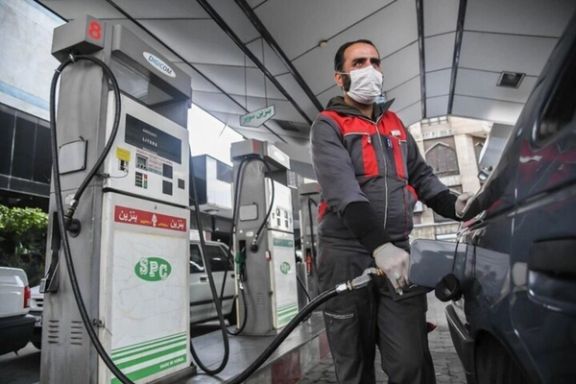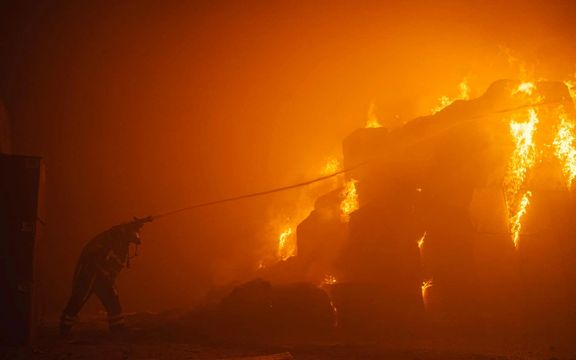Newspaper Says More Than 50 Iranian Soldiers Died On Borders In 3 Years

At least 50 Iranian servicemen have been killed on Iran’s borders in the past three years, Ham-Mihan newspaper in Tehran reported Sunday.

At least 50 Iranian servicemen have been killed on Iran’s borders in the past three years, Ham-Mihan newspaper in Tehran reported Sunday.
The information was published one day after two Iranian soldiers died during clashes with Afghanistan’s Taliban forces on the eastern borders of the country.
The newspaper quoted a former lawmaker representing the restive eastern Sistan-Baluchistan province as saying that he had urged the armed forces and law enforcement during his tenure in parliament to station servicemen from local regions on the border, who know the culture and the terrain.
Soldiers from other areas of the vast country and cities are totally unfamiliar with the dangerous regions on Pakistan and Afghanistan borders, where a lot of drug smuggling takes place.
The lawmaker added that on occasions Iranian soldiers “got so disoriented that by mistake they entered Pakistani territory and into traps set for them.”
Sistan-Baluchistan, with a hot and arid climate, is populated by less than 3 million people, most of whom are ethnic Baluch who are Sunni Muslims, in contrast with the Shiite majority in Iran. Poverty and under-development plague the region.
The Sunni Baluch rallied against the government in September 2022, when nationwide protests engulfed Iran after the death of Mahsa Amini in hijab police custody. Security forces killed nearly 90 civilians in Zahedan, the center of the province on September 30 and weekly protests continue for equality and freedoms.

Amid Western objections over Iran’s arms supplies to Russia, Tehran’s defense minister claims the regime “has no restriction” on exporting and importing weapons.
Brigadier General Mohammad-Reza Ashtiani made the remarks in an interview with Revolutionary Guards-affiliated Tasnim news agency on Sunday, not explaining how this is translated into reality under the US and EU arms embargoes on the country.
“We have no restriction on supplying equipment to [other] countries. We are in contact with all states and keep this contact with our might,” he said and asserted that there is no ban on Iran for buying defense equipment.
However, due to concerns over Iran's nuclear program, in addition to earlier US measures, the EU imposed a full arms embargo on Iran in 2007, which remains in place even after the UN Security Council-imposed restrictions on arms exports to Iran were lifted in October 2020.
The EU sanctions included a prohibition on the direct or indirect supply, sale or transfer of items, materials, equipment, goods and technology, ammunition, military vehicles, paramilitary equipment, and spare parts of all types. Its scope differs from the UN arms embargo in that it includes all types of arms and not only those defined by the UN Register of Conventional Arms.
As part of an international agreement on the Iranian nuclear program, the Joint Comprehensive Plan of Action (JCPOA) of 14 July 2015, the EU agreed to lift its missile technology and arms transfers embargo on Iran eight years after the International Atomic Energy Agency (IAEA) would provide a report to the UNSC to conform that Iran has taken the actions related to its nuclear program specified in the JCPOA.

Therefore, the EU embargoes are scheduled to remain in place until 18 October 2023, and will also be lifted if and when the IAEA reaches the so-called 'Broader Conclusion' in which it determines that all nuclear material in Iran remains in peaceful activities. Such a confirmation has not happened yet, and its prospects seem very dim, considering the fact that Iran is enriching uranium above the levels specified in the JCPOA and has been advancing its ballistic arsenal disregarding its commitments.
On Thursday, Iran unveiled its newest long-range ballistic missile, prompting France and the US to condemn the move as a violation of the United Nations Security Council resolution 2231 of 2015 that endorsed the Iran nuclear deal.
However, it seems that the Islamic Republic feels confident about counting on its allies for arms exports and imports, such as Russia and Venezuela.
Elsewhere in the Sunday interview, Defense Minister Ashtiani said, “The Islamic Republic will help any country that remains committed to international security and peace,” without elaborating how Russia is committed to international peace given its war in Ukraine.
Referring to reports about Iran’s plans to buy Sukhoi Su-35 Russian-made single-seat, twin-engine fighter jets, he said that “if we feel the need…we try to get technological facilities or equipment from any country that possesses them.”
Despite reports indicating a possible shipment of Sukhoi Su-35s in the near future, Ashtiani said “The discussions about the Su-35 fighters are mostly speculations,” adding that some deals may yield a result years after their signing.
Last September, Commander of the Iranian Army’s Air Force Brigadier General Hamid Vahedi said Iran has no plans to buy Sukhoi 30, but it has rather put on its agenda the purchase of Su-35 fighters. In January, Iranian lawmaker Shahriar Heidari said that the Su-35 jets were to arrive in the current Iranian calendar year, which began on March 21.
Ashtiani also referred to a 20-year partnership agreement signed between the Islamic Republic and Venezuela last June to expand ties in various sectors, including military. He said that the defense ministry is coordinating in different fields, among them security and defense.

The Ukrainian government submitted a resolution to parliament on May 27 to impose 50-year-long sanctions on Iran, ostensibly for its supply of weapons to Russia.
Ukrainian Pravda website reported on Sunday that the draft resolution by the National Security and Defense Council of Ukraine "On the application of sectoral special economic and other restrictive measures (sanctions) against the Islamic Republic of Iran,” was submitted to the legislature.
The resolution stipulates a complete trade ban, suspension of transit resources, flights and transportation and prevention of capital outflow by Iranian citizens.
Iran has supplied hundreds of Kamikaze drones to Russia that have been used to target mainly Ukrainian infrastructure and civilians since September 2022. Tehran has denied that it has sent any drones to Moscow since the invasion of Ukraine began in February 2022, but Kyiv has presented overwhelming material evidence showing Russia has used Iranian-made Shahed drones.
Ukraine’s air defenses have learned to shoot down the great majority of the drones, but some slip through anti-aircraft fire and hit civilian targets. A large attack by Iranian drones shook the capital Kyiv on Sunday.
The proposed sanctions package requires the Cabinet of Ministers, the Security Service, the Foreign Intelligence Service, the National Bank and other state authorities to implement and monitor the sanctions.
The document also proposes to prohibit any investment in Iran, transfer of technology and intellectual property rights by residents of Ukraine.
Kyiv also has an ongoing dispute with Tehran over the downing of a civilian airliner belonging to one of its airlines in January 2020 over Tehran by two IRGC missiles which resulted in the death of 176 people onboard. Iran has prevented a independent investigation and a clear report on the incident.

An Iranian official said Sunday that in addition to a limit on cheap gasoline for citizens, more expensive fuel will also be rationed, and limited to 150 liters per month.
Gasoline and other fuels are heavily subsidized in Iran, which coupled with refining limitations, has led to shortages this year according to the government.
In 2019, the government raised gasoline prices to 15,000 rials per liter, or less than 3 US cents in today’s exchange rates. At this price citizens were allowed to buy 60 liters per month, or 15.8 US gallons. But it sold unlimited gasoline at double the minimum price.
The new regulation caps the more expensive gasoline at 150 liters per individual, per month – or 40 gallons. The 60-liter allowance at the cheaper price remains in effect. Overall, gasoline, diesel and natural gas prices in Iran are among the lowest in the world.
Iran’s heavy fuel and electricity subsidies cost the country at least $50 billion a year, while the government struggles to secure foreign currencies amid US economic sanctions.
The government is entertaining the idea of raising fuel prices, but last time when it increased prices in 2019, fierce nationwide protests broke out. Government forces killed at least 1,500 people in one week and badly damaged the regime’s legitimacy.
Five years of economic crisis since the imposition of US sanctions have pushed annual inflation to near 70 percent and the national currency rial has lost its value 12-fold.

Russia unleashed waves of air strikes on Kyiv overnight in what officials said was the largest attack by Iranian drones on the city since the start of the war.
The Russian assault took place as the Ukrainian capital prepared to celebrate the anniversary of its founding on Sunday.
Russia has used hundreds of Iranian-made drones since September 2022 mostly against Ukrainian civilian targets, with stocks being re-plenished as Tehran denied providing the destructive weapon.
Ukraine's Air Force said it downed 52 out of the 54 drones, calling it a record attack with the Iranian-made Shahed 'kamikaze' drones. It was not immediately clear how many of the drones were shot over Kyiv.
In what also appears to be the first deadly attack on Kyiv in May and the 14th assault this month, falling debris killed a 41-year-old man, Mayor Vitali Klitschko said.
Ukrainian President Volodymyr Zelenskyy urged Iran on Wednesday to reconsider the supply of drones to Russia in order to stop a slide into "the dark side of history."
"The simple question is this: what is your interest in being an accomplice to Russian terror?" Zelenskyy said in his nightly video address.

"What is the benefit to Iran of such cynical killing? By Russian hands, but with your weapons, your weapons...Your Shaheds, which terrorize Ukraine every night, mean only that the people of Iran are being driven deeper and deeper into the dark side of history."
The pre-dawn attacks came on the last Sunday of May when the capital celebrates Kyiv Day, the anniversary of its official founding 1,541 years ago. The day is typically marked by street fairs, live concerts and special museum exhibitions - plans for which have been made this year too, but on a smaller scale.
"The history of Ukraine is a long-standing irritant for the insecure Russians," Andriy Yermak, the head of President Volodymyr Zelenskiy's office, said on his Telegram channel.
Air Force said on Telegram that Russia had targeted military and critical infrastructure facilities in the central regions of Ukraine, and the Kyiv region in particular.
With a Ukrainian counteroffensive looming 15 months into the war, Moscow has intensified air strikes after a lull of nearly two months. Waves of attacks now come several times a week.

The Sunday attacks came after Kyiv said that combat clashes eased around the besieged city of Bakhmut in south-eastern Ukraine, the site of the war's longest battle.
Serhiy Popko, the head of Kyiv's military administration, said the attack was carried out in several waves, and air alerts lasted more than five hours.
"Today, the enemy decided to 'congratulate' the people of Kyiv on Kyiv Day with the help of their deadly UAVs (unmanned aerial vehicles)," Popko said on the Telegram messaging channel.
Several districts of Kyiv, by far the largest Ukrainian city with a population of around 3 million, suffered in the overnight attacks, officials said, including the historical Pecherskyi neighbourhood.
Witnesses said that during the air raid alerts that started soon after midnight, many people stood on their balconies, some screaming offensives directed at Russia's President Vladimir Putin and "Glory to air defence" slogans.
In the leafy Holosiivskyi district in the southwestern part of Kyiv, falling debris set a three-storey warehouse on fire, destroying about 1,000 square metres (10,800 square feet) of building structures, Mayor Klitschko said.
A fire broke out after falling drone debris hit a seven-storey non-residential building in the Solomyanskyi district west of the city. The district is a busy rail and air transport hub.
In the Pecherskyi district, a fire broke out on the roof of a nine-storey building due to falling drone debris, and in the Darnytskyi district a shop was damaged, Kyiv's military administration officials said on Telegram.
With reporting by Reuters

Fars news agency affiliated with the Revolutionary Guard Sunday described Iran’s new ballistic missile, Khorramshahr, as super-capable, and a response to Israeli threats.
Saying that the missile can carry a one-ton warhead, which can evade radar and is immune to air defenses, Fars added that Iran introduced the weapon amid Israeli threats of an attack.
Quoting Prime Minister Benjamin Netanyahu and other Israeli officials who have said Israel will do everything in its power to prevent Iran from acquiring nuclear weapons, Fars insisted that “it is the Zionists who constantly seek tensions.”
While the Islamic Republic is dangerously getting closer to the nuclear threshold, the United States has also repeatedly announced that “all options are on the table”. President Joe Biden has vowed not to allow Iran to acquire nuclear weapons.
Fars claimed that top Iranian officials have repeatedly announced that their goal is “peace and instability in the region.” However, Iran’s Islamic regime has constantly threatened Israel with attacks and destruction.
This year, Iranian officials openly called for more attacks by their proxy forces around Israel and to expand their operations, boasting of dozens of daily attacks.
Earlier this month, Iran International reported that the Iranian regime had urged the Palestinian Hamas militant group to join forces with the Islamic Jihad for a new round of attacks against Israel.
Gen. Mohammad-Reza Naghdi, deputy to IRGC's chief commander in April claimed that last year 10,000 attacks took place against Israel taking credit for standing behind what the regime calls “the resistance front.” Naghdi said, “This is the revenge of the Islamic Revolution; the destruction of the Zionist regime.”